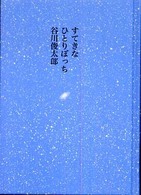- ホーム
- > 洋書
- > 英文書
- > Science / Mathematics
Full Description
Experiments on fracture of materials are made for various purposes. Of primary importance are those through which criteria predicting material failure by deformation and/or fracture are investigated. Since the demands of engineering application always precede the development of theories, there is another kind of experiment where conditions under which a particular material can fail are simulated as closely as possible to the operational situation but in a simplified and standardized form. In this way, many of the parameters corresponding to fracture such as toughness, Charpy values, crack opening distance (COD), etc. are measured. Obviously, a sound knowledge of the physical theories governing material failure is necessary as the quantity of interest can seldom be evaluated in a direct manner. Critical stress intensity factors and critical energy release rates are examples. Standard test of materials should be distinguished from basic experi ments. They are performed to provide routine information on materials responding to certain conditions of loading or environment. The tension test with or without a crack is among one of the most widely used tests. Because they affect the results, with size and shape of the specimen, the rate of loading, temperature and crack configuration are standardized to enable comparison and reproducibility of results. The American Society for Testing Materials (ASTM) provides a great deal of information on recommended procedures and methods of testing. The objective is to standardize specifications for materials and definition of technical terms.
Contents
1 Stress concentrations.- 1.1 Introduction.- 1.2 Advantages and disadvantages of stress analysis methods used to determine stress concentrations.- 1.3 Compilation of results.- 1.4 Geometrically non-linear stress concentrations.- 1.5 Stress concentrations in mixed boundary value problems.- 1.6 Stress concentrations in some specific problems.- 1.7 Stress concentrations in three-dimensional problems.- 1.8 Dynamic stress concentrations.- 1.9 Unconventional approaches to the study of stress concentrations.- References.- 2 Use of photoelasticity in fracture mechanics.- 2.1 Introduction.- 2.2 Analytical foundations for cracked bodies.- 2.3 Experimental considerations.- 2.4 Application of the frozen stress method.- 2.5 Summary and conclusions.- References.- 3 Elastic stress intensity factors evaluated by caustics.- 3.1 Introduction.- 3.2 The basic formulas.- 3.3 The equations of caustics.- 3.4 Properties of the caustics at crack tips.- 3.5 The case of birefringent media.- 3.6 The case of anisotropic media.- 3.7 Interacting crack problems.- 3.8 Branched crack problems.- 3.9 Interface crack problems.- 3.10 V-notch problems.- 3.11 Shell problems.- 3.12 Plate problems.- 3.13 Other applications.- 3.14 Discussion.- 3.15 Conclusions.- References.- 4 Three-dimensional photoelasticity: stress distribution around a through thickness crack.- 4.1 Introduction.- 4.2 Hartranft-Sih plate theory.- 4.3 Triaxial crack border stress field.- 4.4 Experimental considerations: specimens and materials.- 4.5 Test procedure: frozen stress technique.- 4.6 Comparison of Hartranft-Sih theory with experiments.- References.- 5 Experimental determination of dynamic stress intensity factors by shadow patterns.- 5.1 Introduction.- 5.2 Physical and mathematical principles of the method.- 5.3 Theoretical analysisof the shadow pattern after Manogg: Mode-I-loaded stationary crack.- 5.4 Validity of the analysis for stationary cracks under dynamic loading.- 5.5 The dynamic correction for propagating cracks.- 5.6 Experimental technique and evaluation procedure.- 5.7 Applications.- 5.8 Concluding remarks.- References.- 6 Experimental determination of stress intensity factor by COD measurements.- 6.1 Introduction.- 6.2 Principle of the interference optical technique.- 6.3 Determination of stress intensity factor from crack opening displacement.- 6.4 Conclusion.- References.- Author's Index.








